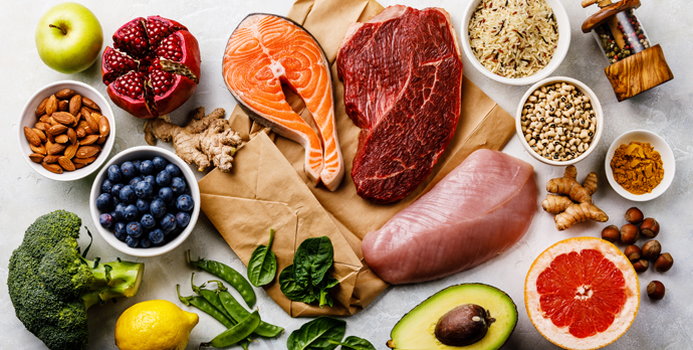Buffalo chicken pizza seemed like a strange combo at first but now is incredibly popular. The cronut, which is a mash-up of a croissant and a doughnut, was introduced to the masses a couple of years ago and people lost their minds over it. Sometimes a mash-up of two things can yield intriguing results, especially if the combination is anything food related.
The latest diet to be picking up steam is called the Pegan Diet, which is a combination of the Paleo Diet and the Vegan Diet. The term was first coined by author and physician Mark Hyman. Hyman first mentioned the moniker the “Pegan Diet" in his diet book Food: What the Heck Should I Eat? published in February of 2018. Hyman recommends that people who follow the Pegan Diet concentrate on what foods they consume, not the amount of food they consume.
The Pegan Diet is more relaxed and therefore may be easier to follow than either the Paleo or Vegan diet alone, allowing more flexibility with food choices, especially when dining away from home.
The Basics
The Pegan Diet emphasizes the importance of eating a plant-based diet as 75 percent of the foods on this diet are supposed to be plants (bonus points if it is locally-produced, organic food). The other 25 percent consists of animal products, such as meat, eggs, and seafood. Dairy and gluten are not allowed, while legumes and grains that are gluten-free may be eaten in very small amounts. Added sugars should be enjoyed only on special occasions. Proteins that are recommended include fatty fish, eggs, and organic, pasture-raised, local meat.
Potential Benefits
Easier to Follow
One plus for this trendy new eating pattern is that it's less rigid and far less exclusionary than either of its parents. The Pegan Diet includes more food choices, making it an easier diet to follow at social settings, such as dinner out with friends or an office luncheon.
Vegetables Abound
The Pegan Diet is plant-based, which confers benefits not only to your health but to the health of this planet as well. This eating pattern boasts that an impressive 75 percent of its core centers on richly-hued vegetables and fruits. These are both low in calories and sky-high in health-bolstering phytochemicals and fiber, helping you prevent heart disease and many types of cancer.
Full of Healthy Fats
Fatty fish, such as salmon, herring, mackerel, trout, sardines, and albacore tuna, which are rich in disease-preventing omega-3 fatty acids, are underscored as the main sources of proteins you should consume on the Pegan Diet. Flax seeds are also encouraged, and these are also excellent sources of omega-3 fats. Most Americans don’t consume enough omega-3 fats, and the Pegan Diet certainly boasts more of these health-promoting fats. The Pegan Diet also emphasizes other types of unsaturated (the healthy kind) fats through various nuts, seeds, avocados, olives and olive oil, and other plant oils.
Limits Added Sugars
Foods with added sugars are prescribed as “special treat foods” to only indulge in occasionally. This would certainly benefit your health and waistline.
Potential Drawbacks
Omits Healthy Grains and Legumes
Eliminating grains and legumes can have negative health consequences, including a higher risk for certain vitamin and mineral deficiencies. Grains and legumes have been consistently shown to improve overall health, and avoiding these foods completely could possibly be hard to sustain over an entire lifetime.
No Dice On Dairy
Since this eating pattern forbids dairy, Pegan followers potentially run the risk of not consuming enough calcium, vitamin D, or protein unless they are educated on how to obtain these nutrients from sources other than dairy foods.
Your Fruit Choices Are Limited
This eating plan limits your fruit options to only berries with a low glycemic index. There is such a vast array of delicious, nutrient-dense fruit to enjoy, and limiting your choices to one category of fruit is not only impractical, it is not warranted by scientific evidence showing any benefit.
Limits Beans
Beans, which are incredibly nutritious, having tons of fiber, protein, and phytochemicals, are only supposed to be eaten occasionally on the Pegan Diets—no more than 1/2 cup per day at most. Beans have a long-standing history of being associated with lowering your risk of cancer and helping you maintain a healthy weight. Don’t banish beans, they’re incredible!
It Can Be Expensive
The Pegan Diet stresses you purchase sustainably-grown, organic, local foods, which can be very expensive and not feasible for anyone on a budget.
The Bottom Line
To date no clinical trials on the Pegan Diet have been conducted, meaning there is no evidence to support any health claims regarding this eating pattern. However, thanks to the fact this eating pattern centers on an abundance of vegetables, fruits, lean proteins, and healthy fats and the encouragement to avoid highly-processed foods, it is definitely nutrient-dense, full of health-promoting fiber, phytochemicals, and omega-3 fatty acids. However, unless you have an intolerance or allergy to gluten, grains, dairy, or legumes, there is no need to eliminate these from your diet as they provide a host of beneficial nutrients, including fiber, B-vitamins, minerals, protein, and phytochemicals.
[Image via Shutterstock]



